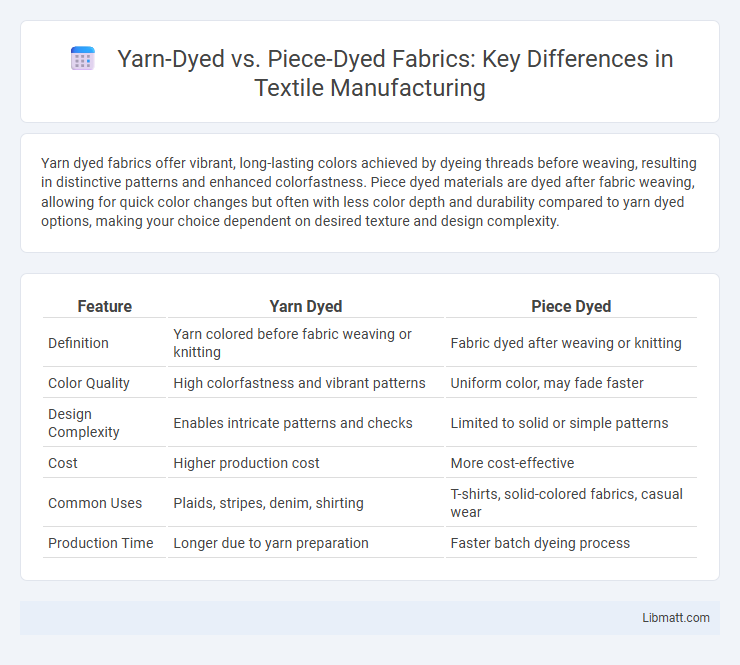Yarn dyed fabrics offer vibrant, long-lasting colors achieved by dyeing threads before weaving, resulting in distinctive patterns and enhanced colorfastness. Piece dyed materials are dyed after fabric weaving, allowing for quick color changes but often with less color depth and durability compared to yarn dyed options, making your choice dependent on desired texture and design complexity.
Table of Comparison
| Feature | Yarn Dyed | Piece Dyed |
|---|---|---|
| Definition | Yarn colored before fabric weaving or knitting | Fabric dyed after weaving or knitting |
| Color Quality | High colorfastness and vibrant patterns | Uniform color, may fade faster |
| Design Complexity | Enables intricate patterns and checks | Limited to solid or simple patterns |
| Cost | Higher production cost | More cost-effective |
| Common Uses | Plaids, stripes, denim, shirting | T-shirts, solid-colored fabrics, casual wear |
| Production Time | Longer due to yarn preparation | Faster batch dyeing process |
Introduction to Yarn Dyed and Piece Dyed Fabrics
Yarn dyed fabrics are created by dyeing the yarns before weaving, resulting in vibrant patterns and long-lasting colorfastness ideal for plaid and striped designs. Piece dyed fabrics undergo the dyeing process after the fabric is woven, offering greater flexibility in color choices and uniform solid colors. Understanding these methods is essential for choosing the right textile for durability, design precision, and production efficiency.
Understanding the Dyeing Process
Yarn dyed fabrics involve coloring individual yarns before weaving, resulting in vibrant, durable patterns with excellent colorfastness and less fading over time. Piece dyed fabrics are dyed after the fabric is woven, offering more flexibility in color choice and faster production but may exhibit less color consistency and durability. Understanding the dyeing process helps you choose the best option based on your needs for pattern precision, fabric strength, and production efficiency.
What is Yarn Dyeing?
Yarn dyeing is a textile process where yarns are dyed before they are woven or knitted into fabric, ensuring deep color penetration and vibrant patterns. This method allows for intricate designs such as stripes or plaids, offering durability and colorfastness superior to piece-dyed fabrics. Understanding yarn-dyed techniques can enhance your selection for quality textiles with long-lasting color integrity.
What is Piece Dyeing?
Piece dyeing refers to the process of dyeing whole fabrics or garments after they have been woven or knitted, rather than dyeing the fibers or yarns beforehand. This method allows for uniform coloration and quick turnaround, making it ideal for large orders and solid color textiles. Your choice of piece dyeing can enhance flexibility in design and cost-effectiveness for producing vibrant, consistent fabric hues.
Key Differences Between Yarn Dyed and Piece Dyed
Yarn dyed fabrics involve coloring the yarn before weaving or knitting, resulting in vibrant patterns and enhanced colorfastness, making them ideal for intricate designs such as plaids and stripes. Piece dyed fabrics are colored after the fabric is woven, offering uniform solid colors and greater flexibility for last-minute color changes. Yarn dyeing generally provides better durability and texture, while piece dyeing is more cost-effective and suitable for mass production of single-color textiles.
Color Fastness and Durability Comparison
Yarn dyed fabrics exhibit superior color fastness because the dye penetrates the fibers before weaving, ensuring vibrant, long-lasting hues resistant to fading from washing and sunlight exposure. Piece dyed textiles, colored after fabric production, often show less durability with increased fading and color bleeding over time due to surface-level dye absorption. The integration of dye in yarn dyed materials enhances overall fabric strength, making them more resilient against wear and tear compared to piece dyed alternatives.
Visual and Textural Differences
Yarn dyed fabrics showcase distinct, vibrant patterns with crisp, well-defined designs due to individual threads being colored before weaving, creating textures that feel rich and slightly varied. Piece dyed fabrics display more uniform color with softer, consistent textures as the dyeing occurs after weaving, resulting in a smooth and even surface. Choosing between yarn dyed and piece dyed affects your garment's visual depth and tactile experience, with yarn dyed offering intricate detail and texture contrast.
Common Applications and Uses
Yarn dyed fabrics are commonly used in high-quality garments such as plaid shirts, denim, and home textiles where pattern durability and colorfastness are essential. Piece dyed fabrics, known for their versatility, are often employed in mass-produced clothing like t-shirts, dresses, and uniforms, allowing for a wide range of colors after fabric production. Your choice between yarn dyed and piece dyed depends on whether you prioritize intricate patterns and long-lasting color or flexibility in color application and cost-efficiency.
Cost Implications and Production Efficiency
Yarn dyed fabrics involve higher initial costs due to the dyeing of individual yarns before weaving, but they offer long-term savings through vibrant, long-lasting colors and reduced risk of color bleeding in finished products. Piece dyed fabrics cost less upfront as the dyeing occurs after fabric weaving, streamlining the production process with faster turnaround times and lower labor requirements. Production efficiency favors piece dyed methods for mass manufacturing, while yarn dyed techniques excel in premium, durable textiles where color precision justifies the increased expense.
Choosing the Right Dyeing Method for Your Needs
Yarn dyed fabric offers vibrant patterns and durability by dyeing the yarn before weaving, ideal for designs requiring intricate detail and colorfastness. Piece dyed fabric involves dyeing the entire piece after weaving, providing cost-effective solutions for solid colors and quick turnaround times. Selecting between yarn dyed and piece dyed depends on the desired fabric appearance, production budget, and colorfastness requirements.
Yarn dyed vs Piece dyed Infographic

 libmatt.com
libmatt.com